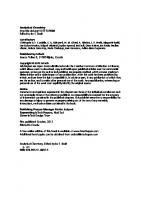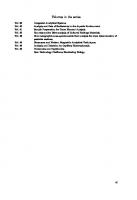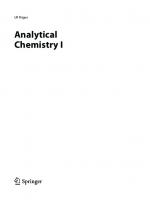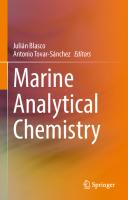Analytical Chemistry [1 ed.] 9789350434086, 9788184881011
This book is a fruitful outcome of this feeling. Besides M.Sc. students, this book will be useful to those students who
154 6 27MB
English Pages 399 Year 2008
Recommend Papers
![Analytical Chemistry [1 ed.]
9789350434086, 9788184881011](https://ebin.pub/img/200x200/analytical-chemistry-1nbsped-9789350434086-9788184881011.jpg)
- Author / Uploaded
- Gurdeep R. Chatwal
- Madhu Arora
File loading please wait...
Citation preview
Analytical Chemistry Gurdeep R. Chatwal Edited by : Madhu Arora
Gflimalaya 'Publishing Gflouse
ANALYTICAL CHEMISTRY
GURDEEPR.CHATVVAL M.Sc., Ph.D.
Fonnerly Reader in ,Chemistry Dyal Singh College, University of Delhi, New Delhi-lJ0003
Edited by:
MADHUARORA
K«)Ji 'flimalaya Gpublishing 'flouse MUMBAI a DELHI a BANGALORE a NAGPUR a HYDERABAD a PUNE a CHENNAI a LUCKNOW a AHMED.'IAD
o
All rights reserved. No part of this publication may be reproduced, stored in a retrieval system, or transmitted in any rorm or by any means, electronic, mechanical, photocopying, recording, or other-wise, without the prior written permission ofthe authors and the publishers. Any infringements will be very stricdy dealtwith according to copyright act.
ISBN: 978-81-84881-01-1 FIRST EDmON : 200~
Published by
M::. 1'.1'!=!!a Pandey for
HIMALAYA. PUBUSHING HOUSE
"Ramdoot", Dr. Bhalerao Marg, Girgaon, Mumbai-400 004. Phones: 23860170/23863863 Fax: 022-23877178 Email: [email protected] Website: www.himpub.com
Branch Offices :
DcllU
: "Po oj a Apartments", 4-B, Murari Lal Street, Ansari Road, Darya Ganj, New Delhi-110 002. Phones: 23270392, 23278631 Reliance: 30180392 to 396 Fax: 011-23256286 Email: [email protected]
Nagpur
: Kundanlal Chandak Industrial Estate, Ghat Road, N:lgpur-440 018. Phone: 2721216, Telefax: 0712-2721215
Bangalore
No. 16/1 (old 12/1), 1st Floor, Next to Hotel Highland, Madhava Nagar, Race Course Road, Bangalore-560 00l. Phone:2281541,2385461 Fax: 2286611
Hydecabad
: No. 2-2-1, 167/2H, 1st Floor, Near Railway Bridge, Tilak Nagar, Main Road, Hyderabad-500 044. Phone: 26501745 Fax: 040-27560041
C.hco.oai
: No.2, Rama Krishna Street, North Usman Road, T-Nagar, Chennai-600 017 Phone: 28144004,28144005 Mobile: 09380460419
Pone
: 527, "Laksh Appartment" Mehunpur, Shaniwerpeth, (Near Prabhat Theatre), Pune-411 030 Mobile: 9421053747
Ludmow
C-43, Sector C, Ali Gunj, Lucknow - 226 024 Phone: 0522-4047594
A.hmedabad
114, Sahil, 1st Floor, Opp. Madhu Sudan House, CG Road, Nawrang Pura, Ahmedabad-380 009. Mobile: 09327324149
Laser Typeset by: TIvink1e Graphics, Delhi-110088. Printed at :.4. to Z Printers, New Delhi.
CONTENTS Chapter 1
Introduction to Analytical Chemistry. • • . . • . . . . . . . . . • . . . • • • . . • . . . . • . .• 1·1 - 1·55 Chapter 2 Errors and Evaluation ............................................. 2-1 - 2·23
Chapter 3 Food Analysis .................................................... ,. 3·1 - 3·44
Chapter 4
Analysis of Water Pollution ........••.••.•.....•.••••.••••••.•••••• 4·1 - 4'103 Chapter 5 Soil Analysis ....................................... '......... , . . . .. 5·1 -
S~12
Chapter 6
Fuel Analysis
. . . . . . . . . . . . . . . . . . . . . . . . . . . . . . . . . . . . . . . . . . . .. 6·1 - 6·49
Chapter 7 Clinic Analysis . . . . . . . . . . . . . . . . . . . . . . . . . . . . . . . . . . . . . . . . . . . . . . . . . . .. 7·1 - 7·50
Chapter 8 Drug Analysis . . . . . . . . . . . . . . . . . . . . . . . . . . . . . . . . . . . . . . . . . . . . . . . . . . . .. S-l - 8·44
"This page is Intentionally Left Blank"
INTRODUCTION TO ANALYTICAL CHEMISTRY Analytical Chemistry Analytical chemistry is concerned with the science of chemical identification and determination of the composition of substances and materials and their chemical structures. The main aim of analytical chemistry is to develop scientifically substantiated methods that allow the qualitative and quantitative evaluation of materials with a certain accuracy. Thus, analytical chemistry provides the methods and tools needed for insight into our material world. According to the means by which an analytical aim can be' achieved, the analytical methods can be divided into the following types : 1. Qualitative Analysis : This includes methods for the identi ficatiol1 or detection methods for the Wlalysis of an unknown substance. It also includes the study of its qualitative composition according to which the material is placed in a certain group of the substances. If the type of substance is known (mineral, salt, alloys, etc.), qualitative analytical methods are used to establish : . (i) The substance the analysed material is composed of, e.g., identification of the grade of an alloy. (ii) The presence or absence of certain chemical elements in the material.
2. Quantitative Analysis : This is concerned with the determination of the total contents of elements, ions or the simplest compounds which constitute the product concerned. Thus, the quantitative analysis seeks ever improved means of measuring the chemical composition of natural and artificial materials. The techniques are available which are used to identify the substances which may be present in a material and to determine the exact amounts of the identified substances. 3. Phase Analysis : The quantitative molecular composition of products is established by phase analysis whose methods are specific for an individual kind of material. Analytical chemistry is related to exact sciences and primarily to mathematics. Analytical results are usually expressed graphically because mathematical functions are used for estimating the accuracy of results provided by analytical methods and for revealing errors of determination. Dielcometry deals with analytical methods based on statistical properties of substances in the bulk. The relation of analytical chemistry to physics is expressed by the increasing application of physical methods of analysis based on the processes of inner electronic and nuclear levels of atoms, e.g., mass s'pectrometry, X-ray analysis, etc. .
Introduction to Analytical Chemistry
1-2
Role of Analytical Chemistry
Analytical chemistry emphasizes the development of great diversity of analytical methods and their various combinations with separations 'a nd concentration methods. These methods and their practical applications could be evaluated by studying their physico-chemical and chemical nature taking into consideration the general regul,ariti,es that determine the procedure of measuring. Analytical chemistry plays an important role in almost all aspects of chemistry, e.g., clinical, agriculture an.d food science, environmental science, forensic science, industrial chemistry, metallurgical science and pharmaceutical science. The v,arious roles of analytical chemistry are qutlined as follows :
1. Clinical Tests : Previously, the doctors made diagnosis c;>f the disease on the basis of symptoms, qualitative clinical results and/or X-ray examinations. Now sensitive chemical and instrumental tests have been devised so as to detect abnormal and norinal components of body fluids because diseases are accompanied by chemical changes occurririg in the metabolic fluids. These test results are very useful for the doctors in diagnosis of the diseases. These tests are usually carried out with blood and urine samples to find out the percentage of glucose, urea, nitrogen, protein, sodium, potassium, calcium, uri~ acid, etc. in blood and urine. Clinical analysis is also helpful in the diagnosis of specific metabolic diseases. It is known that one in 10,000 new born bodies the enzyme phenylalanine hydroxylase is not present and its absence leads to partial developed brain and mental retardation. This disease is known as phenyl ketonuria and is because of an excess of phenyl pyruvate in the urine, In the urine of new born baby, phenyl pyruvate is detected by treating urine samples will FeCl 3 reagent. The appearance of a green blue coloration confirms the presence of phenyl pyruvate.
2. Quality Control of Drugs: Analytical chemistry is successfully used 'to ascertain the quality of the manufactured drug in tablets, solution and emulsion form. The quality of drug affects the therapeutic value. In pharmaceutical studies, it is important to establish the properties and therapeutic value of a drug before the drug is approved and made available to the patients. 3. Role in Industry: Analytical chemistry provides vital role in industry. It provides the means of testing the raw materials, the intermediate compounds and finished products as well as the analytical control of the technological process. For example, ferrous metallurgy requires several analytical tasks such as the control of minerals, concentrates, charge, molten steel, steels of various grades, refractory materials, fluxes, exhaust gases, sewage etc. Similarly, non-ferrous metallurgy requi~ .•several analytical tasks. As a result, it is essential for a metallurgical engineer t~Jlave a clear understanding - of the modem methods of analysing raw materials and pfbducts as well as *e methods for the control of technological processes. Similarly, ~~ quality of finished products such as household products, fuels, paints, etc.; can 9.e analysed by the procedures developed by analytical chemists before selling to the consumers. I
Analytical methods in industry are worked out in field research institutes and' plant laboratories for each type of material. Analytical control should be characterised by
Introduction, to Analytical Chemistry
1·3
a short duration of analysis, high selectivity, accuracy and sensitivity, reductionlh man-power and power saving. It is possible to control all these demands by introducing the technical means of analytical control i.e., mechanisation, instrumental methods, automation and computers. Depending on the material under analytical control and aim of analysis, the marking analysis and the quick analysis are employed. Marking analysis is used to evaluate the quality of semi finished and finished products and then- compliance with the accepted standards. On the other hand, the quick analysis is employed for the routine control of semi finished and finished products. The quick analysis is carried out by using .'volumetric, spectrophotometric and some physicochemical methods.
4. Environmental Quality: It is usually evaluated by testing the suspected contaminants by using the various techniques of analytical chemistry.
5. Food Analysis: The nutritional value of food is found out by chemical analysis for major components such as proteins, carbohydrates, vitamins and trace minerals. Also, the calories in food are usually calculated from its chemical analysis.
6. High Purity Materials : It is not possible to obtain high purity materials unless production processes are provided with analytical control methods at each important stage.
7. Miscellaneous Applications: An analytic,al chemist also makes important contribution to fields as diverse as forensics, archaeology and space science.
Classification on Analytical Methods The classification of analytical methods is done according to the property that is observed in the final measurement process. On this basis, the analytical methods are divided into two large classes: 1. Classical or chemical methods 2. Instrumental or physicochemical methods of analysis Let us discuss these one by one.
1. Classical or Chemical Methods These depend on analytical chemical reactions. In qualitative analysis identification methods involve reactions producing external effects, such as formation of precipitates or coloured solutions, ga'S evolution, change in colour of the material being analysed, etc. In quantitative analysis, chemical reactions help in measuring the amount of reaction product oTofthe reagent consumed. Examples of classical methods are as follows : (i)
Volumetric analysis
(ii) Gravimetric analysis (iii) Gas analysis
1-4
Introduction to Analytical- Chemistry
\ . Volumetric analysis is known as titrimetric analysis. It involves the measurement of the volume of reagent of exactly known concentration used up in the titration. The equivalence point should be detected. Equivalence point is the moment when the amount of standard solution added IS equivalent to that of the substance being determined. The equivalence point can be determined by: (i) A change in the colour of the reactants themselves or indicators which are introduced
into the analytical solutions. (ii)
A change
IS
some physicochemical properties of the analyt measured instrumentally.
If an indicator is used in volumetric titration, a sharp change in the colour of an mdicator indicates that the end point is reached. However, the end point and the equivalence point of the titration may not be identical because the end point depends on: (i) The indicator used, (ii) The properties of the titrant and the standard solution, and
(iii) The properties of the reaction products. A wide variety of the types of chemical reactions can be followed by titration methods such as neutralisation reactions, oxidation-reduction reactions, precipitation reactions and complex formation reactions.
-
Gravimetric method depends on the conversion of the substance concerned to an insoluble reaction product of definite chemical composition and an accurate determination of its mass. This method is used for the estimation of various cations and anions, e.g., Ba2+, SOl-, Ag+, Cl-, Pb 2+, Ni2+ , Zn 2+, Mn2+ , Cu2+, CrO42-' etc . Gas analysis is a special type of quantitative analysis which is based on the measurement of the volume or mass of the gas driven off from the analysed sample. Gas analysis is used for controlling many industrial processes such as the analysis of flue gases, original gas materials and the products of their chemical conversion. This process is also used for determining elements such as sulphur, nitrogen, phosphorus, arsenic, etc.; which forms persistent gases.
The apparatus needed for classical methods is cheap and readily available in all laboratories. There is need to calibrate a sample of known composition. The classical methods are suitable for non-routine and occasional analysis. The classical methods are often simpler because there is no need in taking the trouble of preparing requisite standard and carrying out the calibration of an instrument.
Advantages of Classical Methods (i) Procedure is simple and accurate.
(ii) Equipment needed is cheap and readily available in all laboratories. (iii) Methods are based on absolute measurement.
(iv) Specialised training is usually not required. (v) There is no need to calibrate a sample of known composition.
(vi) These methods are suitable for a non-routine and an occasional analysis.
Introduction to Analytical Chemistry
1'5
Limitations or Disadvantages of Classical Methods (i) Procedure is time consuming. (ii) There is a lack of versatility. (iii) There is a lack of specificity.
(iv) Accuracy decreases with decreasing amounts. (v) Chemical environment is critical.
2. Instrumental or Physicochemical Methods of Analysis These are concerned with the measurement of certain physical parameters of a chemical system that are dependable on the nature of the system components and vary in the process of reaction. These parameters include electric potential, electrical conductance, electrical current, quantity of electricity, absorption of radiation, emission of radiation, scattering of radiation, refraction of radiation, rotation of radiation, diffraction of radiation and thermal properties. Table 1 lists the various instrumental methods used in analysis. Table 1
Physical property measured
7nstrumental methods based on measurement of property
1.
Electrical potential, electrical conductance, electrical current, quantity of electricity etc.
Conductometry, potentiometry voltammetry, chronopotentiometry. Polarography, amperometry and coulometry, (electrometric or electroanalytical methods).
2.
Absorption of radiation.
Spectrophotometry (X-ray, UV, Visible, IR, colorimetry, atomic absorption, nuclear magnetic resonance and electron spin resonance).
3.
Emission of radiation.
Emission spectroscopy, flame photometry, fluorescence, radiochemical methods.
4.
Scattering of radiation.
Turbidimetry, nephelometry. Raman Spectroscopy.
5. Refraction of radIation.
Refractometry, interferometry.
6. Rotation of radiation.
Polarimetry, optical rotatory dispersion.
7.
X-ray electron diffraction methods.
I?iffraction of radiation.
8. "Mass to charge ratio.
Mass spectrometry.
9. Thermal properties.
Thermal conductivity and enthalpy methods.
Instruments used in instrumental methods are .expensive and their use will be justified if numerous samples have to be analysed or when dealing with the determination of substances present in minute quantities (trace, subtrace, ultratrace analysis), with instrumental methods, it becomes necessary to carry out a calibration operation using a sample of material of known composition as reference substance. Instrumental m~thods are ideal suited to the performance of a large number of determinations.
Introduction to Analytical Chemistry
1'6
Advantages of Instrumental (i)
l~/ethods
Instrumental methods of analysis are usually much faster than purely classical methods.
(ii) Instrumental methods of analysis are nonnally applicable at much lower concentrations of the samples than classical methods. (iii) High sensitivity of instrumental methods can be attained. (iv) (v)
Complex samples can be handled by instrumental techniques. Instrumental methods have wide applications in industry.
(vi) In most cases a microcomputer can be interfaced to the instrument so that all the curves can be plotted automatically and whole analytical process may be automated completely.
Limitations of Instrumental Methods (i)
An initial or continuous calibration is necessary.
(ii) The sensitivity and the accuracy depend upon the ins~ments or wet chemical methods. (iii) The cost of instrument is large and most of the college labs are unable to purchase them. (iv) The concentration range is limited. (v)
(vi)
Sizable space is required. Specialised training is required.
Differences between Classical and Instrumental Methods The various differences between classical and instrumental methods are given in Table 2. Table 2 Classical Methods
Instrumental Methods
1. The apparatus needed for classical methods is cheap and readIly available in all laboratories.
1. The instruments needed for instrumental methods are expensive.
2. In classical methods, it is not necessary to cahbrate a sample of known composition.
2. In the instrumental methods, it is necessary to carry out a calibration operation using a sample of material of known composition as reference substance.
3. The classical methods are suitable for nonroutine as well as occasional analysis.
3. The instrumental methods are ideally suited to the performance of a large number of routine determinations.
From the above differences it could be concluded that classical and instrumental methods are supplementing each other.
Types of Instrumental Analysis In instrumental analysis, a physical property of a substance is measured to detennine jts chemical composition by employing special instruments (potential, current, conductance, absorption and emission spectra, etc.) .. Physical properties are of two types, namely specific and non-
1-7
Introduction to Analytical Chemistry
specific. A direct measurement is, however, possible if the measured property is specific for the_ substance being measured. If no specific property is available, the measurement of two or more non-specific properties may allow correction for interfering substances. Instrumental methods are based on the theory of relations between the content and the corresponding physicochemical and physical properties of the chemical system being analysed. Changes in the system properties may be either detected or recorded through the measurement of current, electrode potential, electric conductance, optical density, refractive index, etc.; with suitable and sensitive instruments. It is possible to divide instrumental analysis into two types such as direct or indirect, depending on the procedure of the determination. In direct instrumental analysis, a substance is determined directly by measuring some property of the system. In indirect instrumental analysis, a change in property is used for detecting the end point of a chemical reaction, i.e. it serves as a peculiar sensitive indicator. Instrumental methods of analysis can be classified into two broad groups: spectral (optical) and electrochemical methods. The instrumental optical methods are based on the relation between optical properties of a system and its composition. The electrochemical methods are based on the interdependence of electrochemical properties and composition of the system. In addition to these groups, radiometric, mass spectral and a number of other methods have also been used widely in quantitative analysis, and. their number is fast growing day by day. Physical and physicochemical methods are highly sensitive and rapid and so permit the determination of ultrasonic amounts of substances as little as 10-7 or even 10-9 percent. Table 3 : Classification of Instrumental Methods of Chemical Analysis Methods
Quantity or Property measured
Phenomenon underlying the method
(A) t









